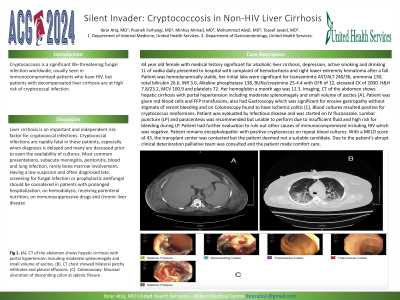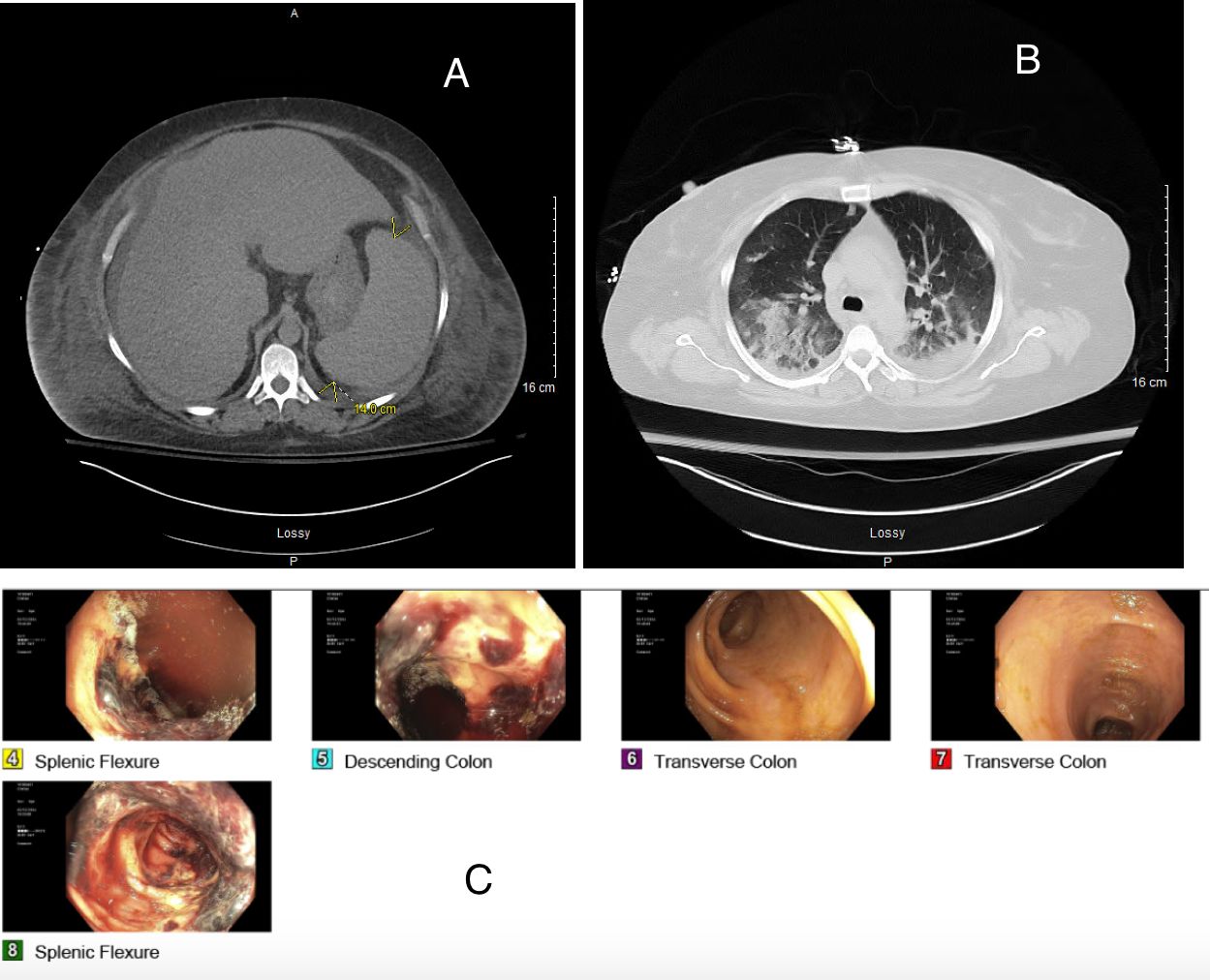Tuesday Poster Session
Category: Liver
P4727 - Silent Invader: Cryptococcosis in Non-HIV Liver Cirrhosis
Tuesday, October 29, 2024
10:30 AM - 4:00 PM ET
Location: Exhibit Hall E


Ibrar Atiq, MD
United Health Services, Wilson Medical Center
Binghamton, NY
Presenting Author(s)
Ibrar Atiq, MD, Pooneh Farhangi, MD, Minhaz Ahmad, MD, Mohammad Abidi, MD, Toseef Javaid, MD
United Health Services, Wilson Medical Center, Binghamton, NY
Introduction: Cryptococcosis is a significant life-threatening fungal infection worldwide, usually seen in immunocompromised patients who have HIV, but patients with decompensated liver cirrhosis are at high risk of cryptococcal infection.
Case Description/Methods: 44 year old female with medical history significant for alcoholic liver cirrhosis, depression, active smoking and drinking 1L of vodka daily presented to hospital with complaint of hematochezia and right lower extremity hematoma after a fall. Patient was hemodynamically stable, her initial labs were significant for transaminitis AST/ALT 240/36, ammonia 130, total bilirubin 26.6, INR 3.6, Alkaline phosphatase 138, BUNs/creatinine 25-4.4 with GFR of 12, elevated CK of 2000. H&H 7.8/23.2, MCV 100.9 and platelets 72. Her hemoglobin a month ago was 12.3. Imaging, CT of the abdomen shows hepatic cirrhosis with portal hypertension including moderate splenomegaly and small volume of ascites[A]. Patient was given red blood cells and FFP transfusions, also had Gastroscopy which was significant for erosive gastropathy without stigmata of recent bleeding and on Colonoscopy found to have ischemic colitis[C]. Blood cultures resulted positive for cryptococcus neoformans. Patient was evaluated by Infectious disease and was started on IV fluconazole. Lumbar puncture (LP) and paracentesis was recommended but unable to perform due to insufficient fluid and high risk for bleeding during LP. Patient had further evaluation to rule out other causes of immunocompromised including HIV which was negative. Patient remains encephalopathic with positive cryptococcus on repeat blood cultures. With a MELD score of 43, the transplant center was contacted but the patient deemed not a suitable candidate. Due to the patient's abrupt clinical deterioration palliative team was consulted and the patient made comfort care.
Discussion: Liver cirrhosis is an important and independent risk factor for cryptococcal infections. Cryptococcal infections are rapidly fatal in these patients, especially when diagnosis is delayed and many are deceased prior to even the availability of cultures. Most common presentations, subacute meningitis, peritonitis, blood and lung infection, rarely bone marrow involvement. Having a low suspicion and often diagnosed late, screening for fungal infection or prophylactic antifungal should be considered in patients with prolonged hospitalization, on hemodialysis, receiving parenteral nutrition, on immunosuppressive drugs and chronic liver disease.

Disclosures:
Ibrar Atiq, MD, Pooneh Farhangi, MD, Minhaz Ahmad, MD, Mohammad Abidi, MD, Toseef Javaid, MD. P4727 - Silent Invader: Cryptococcosis in Non-HIV Liver Cirrhosis, ACG 2024 Annual Scientific Meeting Abstracts. Philadelphia, PA: American College of Gastroenterology.
United Health Services, Wilson Medical Center, Binghamton, NY
Introduction: Cryptococcosis is a significant life-threatening fungal infection worldwide, usually seen in immunocompromised patients who have HIV, but patients with decompensated liver cirrhosis are at high risk of cryptococcal infection.
Case Description/Methods: 44 year old female with medical history significant for alcoholic liver cirrhosis, depression, active smoking and drinking 1L of vodka daily presented to hospital with complaint of hematochezia and right lower extremity hematoma after a fall. Patient was hemodynamically stable, her initial labs were significant for transaminitis AST/ALT 240/36, ammonia 130, total bilirubin 26.6, INR 3.6, Alkaline phosphatase 138, BUNs/creatinine 25-4.4 with GFR of 12, elevated CK of 2000. H&H 7.8/23.2, MCV 100.9 and platelets 72. Her hemoglobin a month ago was 12.3. Imaging, CT of the abdomen shows hepatic cirrhosis with portal hypertension including moderate splenomegaly and small volume of ascites[A]. Patient was given red blood cells and FFP transfusions, also had Gastroscopy which was significant for erosive gastropathy without stigmata of recent bleeding and on Colonoscopy found to have ischemic colitis[C]. Blood cultures resulted positive for cryptococcus neoformans. Patient was evaluated by Infectious disease and was started on IV fluconazole. Lumbar puncture (LP) and paracentesis was recommended but unable to perform due to insufficient fluid and high risk for bleeding during LP. Patient had further evaluation to rule out other causes of immunocompromised including HIV which was negative. Patient remains encephalopathic with positive cryptococcus on repeat blood cultures. With a MELD score of 43, the transplant center was contacted but the patient deemed not a suitable candidate. Due to the patient's abrupt clinical deterioration palliative team was consulted and the patient made comfort care.
Discussion: Liver cirrhosis is an important and independent risk factor for cryptococcal infections. Cryptococcal infections are rapidly fatal in these patients, especially when diagnosis is delayed and many are deceased prior to even the availability of cultures. Most common presentations, subacute meningitis, peritonitis, blood and lung infection, rarely bone marrow involvement. Having a low suspicion and often diagnosed late, screening for fungal infection or prophylactic antifungal should be considered in patients with prolonged hospitalization, on hemodialysis, receiving parenteral nutrition, on immunosuppressive drugs and chronic liver disease.

Figure: A. CT of the abdomen shows hepatic cirrhosis with portal hypertension including moderate splenomegaly and small volume of ascites. B. CT chest showed bilateral patchy infiltrates and pleural effusions. C. Colonoscopy: Mucosal ulceration of descending colon at splenic flexure.
Disclosures:
Ibrar Atiq indicated no relevant financial relationships.
Pooneh Farhangi indicated no relevant financial relationships.
Minhaz Ahmad indicated no relevant financial relationships.
Mohammad Abidi indicated no relevant financial relationships.
Toseef Javaid indicated no relevant financial relationships.
Ibrar Atiq, MD, Pooneh Farhangi, MD, Minhaz Ahmad, MD, Mohammad Abidi, MD, Toseef Javaid, MD. P4727 - Silent Invader: Cryptococcosis in Non-HIV Liver Cirrhosis, ACG 2024 Annual Scientific Meeting Abstracts. Philadelphia, PA: American College of Gastroenterology.
